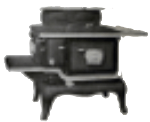Understanding the Features of a Stove
Stoves between the 1910s and 1930s were often sold in ranges with various models displaying a variety of available features. This includes more aesthetic features such as adding enameled doors, a process done by fusing powdered glass to the stove by firing to create a smooth and durable coating, done on base materials like cast iron. Especially while cast iron was the most popular material for making stoves, other coatings like Japan black were advertised. Japan black is a black lacquer for steel or iron that was named such for the lacquer’s association in the West with the products of Japan. This name was also used as a verb, so stoves were sometimes described as being japanned.
There are also the practical features that change the physical design as well, but for the purpose of changing the overall function. For example, some stoves feature a reservoir which makes them capable of heating water without needing to use other stove spaces. Not everyone wants a feature like this, some people are only looking for a tea shelf right beside the stovetop. There are also additional components like high shelves and warming closets given as options situated above the body of the stove that are available in various combinations and styles desired to fit different budgets and tastes.
Below is a flipbook of the "Happy Thoughts" cooking ranges put out by the William Buck Stove Company around 1910. This shows how the stoves are all under one name but are all different ‘cuts’ to include the elements needed for a given home.
Flipbook made of "Happy Thoughts" Cooking Ranges book made by the William Buck Stove Company around 1910, a manufacturer of kitchen ranges. (Omeka entry in the Collection Gallery)
